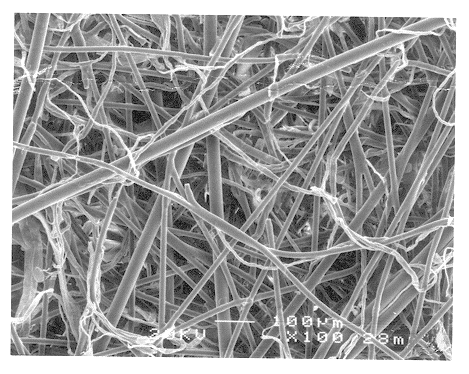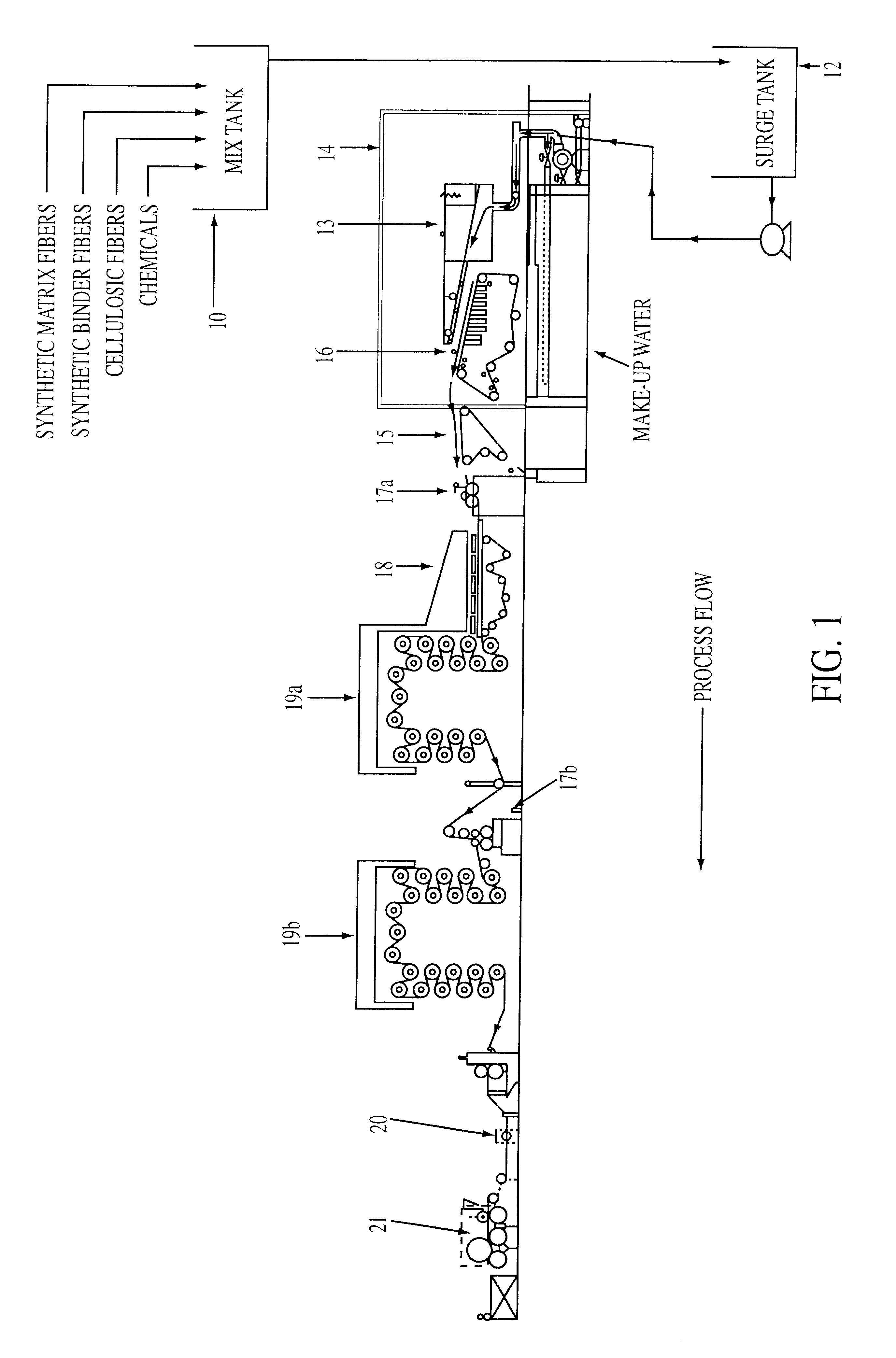High efficiency thermally bonded wet laid milk filter
a technology of thermal bonding and wet milk, which is applied in the direction of filter paper, filtration separation, separation processes, etc., can solve the problems of adversely affecting the flow rate and significant reduction of the open pore area of the fabric, so as to improve the flow rate, improve the filtration properties, and improve the effect of flow
- Summary
- Abstract
- Description
- Claims
- Application Information
AI Technical Summary
Benefits of technology
Problems solved by technology
Method used
Image
Examples
example 1
(Product 1)
50.0% 2.2 denier by 3 / 4" polyethylene / polypropylene sheath / core bicomponent fiber (Type 441, Hercules Inc., Now: Fiber Visions.RTM., Covington, Ga.)
32.0% 15 denier by 11 / 2" polyester fiber (Type 108, KoSa Fibers, Charlotte, N.C.; formally Hoechst-Celanese Fibers Co., Salisbury, N.C.)
12.0% Viscokraft.RTM. bright alpha hardwood pulp (International Paper Co., Purchase, N.Y.)
3.0% chemically treated softwood pulp (Type NHB405, Weyerhaeuser Paper Co., New Bern, N.C.)
3.0% 1 denier by 4 mm polyvinyl alcohol fiber (Type VPB 105-2, Kuraray Co., Ltd., Osaka, Japan)
0.5% to 6.0% (percentage calculated based on the total dry weight of the final fabric) Freesol.RTM. OT-75 rewetting surfactant--sodium dioctyl sulfosuccinate in a mixture of ethanol and water (BF Goodrich, formally Freedom Textile, Charlotte, N.C.) is added to the fiber slurry to obtain the required surface wet out. A preferred surface wet out for filtration fabrics of this invention is about 0.5 seconds to 2.0 seconds. We...
example 2
(Alternate Product 1)
51.5% 2.2 denier by 3 / 4" polyethylene / polypropylene sheath / core bicomponent fiber (Type 441, formerly Hercules Inc., now Fabric Visions.RTM., Covington, Ga.)
33.5% 15 denier by 11 / 2" polyester fiber (Type 108, KoSa Fibers, Charlotte, N.C.; formally Hoechst-Celanese Fibers Co., Salisbury, N.C.)
12.0% Viscokraft.RTM. bright alpha hardwood pulp (International Paper Co., Purchase, N.Y.)
3.0% chemically treated softwood pulp (Type NHB405, Weyerhaeuser Paper Co., New Bern, N.C.)
The filtration fabric of this example is convertible into disk, tube or sock filters on some converting equipment and only disk filters on other equipment due to its soft hand.
example 3
(Product 2)
50.0% 2 denier by 5 mm polyester / polyester concentric sheath / core bicomponent fiber (Type N720H, Kuraray Co., Ltd., Osaka, Japan)
25.0% 15 denier by 11 / 2" polyester fiber (Type 108, KoSa Fibers, Charlotte, N.C.; formally Hoechst-Celanese Fibers Co., Salisbury, N.C.)
17.0% Viscokraft.RTM. bright alpha hardwood pulp (International Paper Co., Purchase, N.Y.)
8.0% chemically treated softwood pulp (Type NHB405, Weyerhaeuser Paper Co., New Bern, N.C.)
Trial production runs of this fabric were conducted on International Paper's pilot line at their Corporate Research Center (Tuxedo, N.Y.) at three different basis weights: 2.5 oz / yd.sup.2 (Fabric A), 2.2 oz / yd.sup.2 (Fabric B) and 1.9 oz / yd.sup.2 (Fabric C). The filtration fabrics of this example can be converted into disk, tube or sock filters.
The physical properties of the three basic weight fabrics of example 3 were characterized as follows:
The physical properties of the three basic weight fabrics of example 3 were characterized as...
PUM
| Property | Measurement | Unit |
|---|---|---|
| length | aaaaa | aaaaa |
| length | aaaaa | aaaaa |
| width | aaaaa | aaaaa |
Abstract
Description
Claims
Application Information
 Login to View More
Login to View More - R&D
- Intellectual Property
- Life Sciences
- Materials
- Tech Scout
- Unparalleled Data Quality
- Higher Quality Content
- 60% Fewer Hallucinations
Browse by: Latest US Patents, China's latest patents, Technical Efficacy Thesaurus, Application Domain, Technology Topic, Popular Technical Reports.
© 2025 PatSnap. All rights reserved.Legal|Privacy policy|Modern Slavery Act Transparency Statement|Sitemap|About US| Contact US: help@patsnap.com


